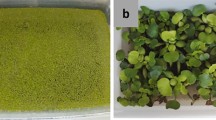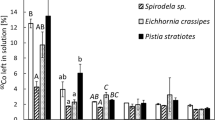Abstract
Phytoremediation potential of duckweeds (Lemna minuta, Lemna minor) to remove nutrients from simulated wastewater was analyzed. In two separate experiments, the two species were grown for 28 days in waters enriched with nitrate and phosphate to simulate nutrient concentrations of domestic wastewater. Water physical and chemical measurements (temperature, pH, conductivity, oxygen) and plant physiological and biochemical analysis (biomass, relative growth rate–RGR, nutrient and chlorophyll contents, peroxidative damage, bioconcentration factor–BCF) were made to test and compare the phytoremediation capacity of the two Lemna species. L. minuta biomass increased almost tenfold during the time-course of the treatment resulting in a doubling of the mat thickness and a RGR of 0.083 ± 0.001 g/g day. Maximum frond content of phosphate was reached by day 21 (increase over 165%) and nitrate by day 7 (10%). According to the BCF results (BCF > 1000), L. minuta was a hyperaccumulator for both nutrients. On the other hand, L. minor biomass and mat thickness decreased continuously during incubation (RGR = − 0.039 ± 0.004 g/g day). In L. minor fronds, phosphate content increased until day 14, after which there was a decrease until the end of the incubation. Frond nitrate content significantly decreased by day 7, but then remained relatively constant until the end of the experiment. L. minor proved to be hyperaccumulator for phosphates, but not for nitrates. Results indicated L. minuta has a greater potential than L. minor to remove both nutrients by bioaccumulation, especially phosphates, demonstrated also by better physiological and biochemical responses. However, during the incubation, the chlorophyll content of L. minuta mat did continuously decrease and peroxidative damage had increased until day 14, indicating that the system was under some kind of stress. Strategies to avoid this stress were discussed.






Similar content being viewed by others
References
Bailly C, Benamar A, Corbineau F, Côme D (1996) Changes in malondialdehyde contents and in superoxide dismutase, catalase and glutathione reductase activities in sunflower seed as related to deterioration during accelerated aging. Physiol Plant 97:104–110
Baker AJM (1981) Accumulators and excluders-strategies in the response of plants to heavy metals. J Plant Nutr 3:643–654
Boniardi N, Vatta G, Rota R, Nano N, Carrà S (1994) Removal of water pollutants by Lemna gibba. Chem Eng J Biochem Eng J 54 (2):41–48
Borin M (2003) Fitodepurazione. Soluzioni per il trattamento dei reflui con le piante. Edagricole, Bologna
Ceschin S, Abati S, Leacche I, Iamonico D, Iberite M, Zuccarello V (2016a) Does the alien Lemna minuta show an invasive behavior outside its original range? Evidence of antagonism with the native L. minor in central Italy. Int Rev Hydrobiol 101(5–6):173–181
Ceschin S, Della Bella V, Piccari F, Abati S (2016b) Colonization dynamics of the alien macrophyte Lemna minuta Kunth: a case study from a semi-natural pond in Appia Antica Regional Park (Rome, Italy). Fundam Appl Limnol 188:93–101
Ceschin S, Leacche I, Pascucci S, Abati S (2016c) Morphological study of Lemna minuta Kunth, an alien species often mistaken for the native L. minor L. (Araceae). Aquat Bot 131:51–56
Ceschin S, Abati S, Ellwood NTW, Zuccarello V (2018a) Riding invasion waves: spatial and temporal patterns of the invasive Lemna minuta from its arrival to its spread across Europe. Aquat Bot 150:1–8
Ceschin S, Abati S, Leacche I, Zuccarello V (2018b) Ecological comparison between duckweeds in central Italy: the invasive Lemna minuta vs the native L. minor. Plant Biosyst 152:674–683
Ceschin S, Abati S, Traversetti L, Spani F, Del Grosso F, Scalici M (2019a) Effects of the invasive duckweed Lemna minuta on aquatic animals: evidence from an indoor experiment. Plant Biosyst 153(6):749–755
Ceschin S, Sgambato V, Ellwood NTW, Zuccarello V (2019b) Phytoremediation performance of Lemna communities in a constructed wetland system from Central Italy. Exp Appl Bot 162:67–71
Cheng J, Landesman L, Bergmann BA, Classen JJ, Howard JW, Yamamoto YT (2002) Nutrient removal from swine lagoon liquid by Lemna minor 8627. Trans ASAE 45:1003–1010
Chiudioni F, Trabace T, Di Gennaro S, Palma A, Manes F, Mancini M (2017) Phytoremediation applications in natural condition and in mesocosm: the uptake of cadmium by Lemna minuta Kunth, a non-native species in Italian watercourses. Int J Phytoremediation 1:371–376
Cui W, Cheng JJ (2015) Growing duckweed for biofuel production: a review. Plant Biol J 17:16–23
D’Imperio M, Montesano FF, Renna M, Leoni B, Buttaro D, Parente A, Serio F (2018) NaCl stress enhances silicon tissue enrichment of hydroponic “baby leaf” chicory under biofortification process. Sci Hortic 235:258–263
DAISIE (2008) European invasive alien species gateway. http://www.europe-aliens.org/
Driever SM, Nes EH, Roijackers RMM (2005) Growth limitation of L. minor due to high plant density. Aquat Bot 81:245–251
Dukes JS, Mooney HA (1999) Does global change increase the success of biological invaders? TREE 14:135–139
Dussart G, Robertson J, Bramley J (1993) Death of a lake. Biol Sci Rev 5(5):8–10
Glass ADM, Britto DT, Kaiser BN, Kinghorn JR, Kronzucker HJ, Kumar A, Okamoto M, Rawat S, Siddiqi MY, Unkles SE, Vidimar JJ (2002) The regulation of nitrate and ammonium transport systems in plants. J Exp Bot 53(370):855–864
Heath RL, Packer L (1968) Photoperoxidation in isolated chloroplasts: I. Kinetics and stoichiometry of fatty acid peroxidation. Arch Biochem Biophys 125:189–198
Huang F, Guo Z, Xu Z (2007) Determined methods of chlorophyll from Lemma paucicostata. Exp Technol Manag 24:29–31
Iamonico D, Abati S, Iberite M (2010) Lemna minuta Kunth (Araceae) nel Lazio (Italia centrale): note morfologiche e osservazioni sui caratteri d’invasività. In: Proc. 18th Meeting Forum Natura Mediterraneo on “Le specie aliene nel Mediterraneo”, 2010 March 20–21; Paliano, Italy. http://www.naturamediterraneo.com/primoconvegnoNM/
Janes RA, Eaton JW, Hardwick K (1996) The effects of floating mats of Azolla filiculoides Lam. and Lemna minuta Kunth on the growth of submerged macrophytes. Hydrobiologia 340(1–3):23–26
Körner S, Sk D, Veenstra S, Vermaat JE (2003) The capacity of duckweed to treat wastewater: ecological consideration for a sound design. J Environ Qual 32:1583–1590
Landolt E (1986) The family of Lemnaceae. In: A monographyc study, vol 2. Veröff Geobot Inst ETH, Stifung rübel, Zurich
Landolt E (1992) Lemnaceae: duckweed family. J Ariz Nev Acad Sci 26:10–14
Landolt E, Kandeler R (1987) Biosystematic investigations in the family of duckweeds (Lemnaceae), vol 4. Geobotanischen Instutites der ETH, Zurich
Laube HR, Whole JR (1973) Studies on the decomposition of a duckweed (Lemnaceae) community. Bull Torr Bot Club 100(4):238–240
Lemon GD, Gordon D, Posluszny U, Husband BC (2001) Potential and realized rates of vegetative reproduction in Spirodela polyrhiza, Lemna minor, and Wolffia borealis. Aquat Bot 70:79–87
Mariani F, Di Giulio A, Fattorini S, Ceschin S (2020) Experimental evidence of the consumption of the invasive alien duckweed Lemna minuta by herbivorous larvae of the moth Cataclysta lemnata in Italy. Aquat Bot 161: 103172
Masotti L, Verlicchi P (2005) Depurazione delle acque di piccole comunità. Tecniche naturali e tecniche impiantistiche. Hoepli ed. Milano (in Italian)
Mkandawire M, Dudel EG (2007) Are Lemna spp. effective phytoremediation agents? Biorem Biodiv Bioavail 1:56–71
Mkandawire M, Dudel EG, Taubert B (2004) Accumulation of Uranium in Lemna gibba L. in relation to milieau conditions of tailing waters in abandoned uranium mines in Germany. In: Jarvis AP, Dudgeon BA, Younger PL (eds) Mine water - process, policy and progress. University of Newcastle upon-Tyne Press, Newcastle, pp 9–18
Njambuya J, Stiers I, Triest L (2011) Competition between Lemna minuta and Lemna minor at different nutrient concentrations. Aquat Bot 94:158–164
Ozengin N, Elmaci A (2007) Performance of duckweed (Lemna minor L.) on different types of wastewater treatment. J Environ Biol 28:307–314
Paisio CE, Fernandez M, González PS, Talano MA, Medina MI, Agostini E (2017) Simultaneous phytoremediation of chromium and phenol by Lemna minuta Kunth: a promising biotechnological tool. Int J Environ Sci Technol 15:37–48
Paolacci S, Harrison S, Jansen MAK (2016) A comparative study of the nutrient responses of the invasive duckweed Lemna minuta, and the native co-generic species Lemna minor. Aquat Bot 134:47–53
Patel DK, Kanungo VK (2010) Phytoremediation potential of duckweed (Lemna minor L: a tiny aquatic plant) in the removal of pollutants from domestic wastewater with special reference to nutrients. Bioscan 5:355–358
Pietrini F, Bianconi D, Massacci A, Iannelli MA (2016) Combined effects of elevated CO2 and Cd-contaminated water on growth, photosynthetic response, Cd accumulation and thiolic components status in Lemna minor L. J Hazard Mater 309:77–86
Pokorný J, Rejmánková E (1983) Oxygen regime in a fishpond with duckweeds (Lemnaceae) and Ceratophyllum. Aquat Bot 17:125–137
R Core Team (2018) R: A language and environment for statistical computing. R Foundation for Statistical Computing, Vienna https://www.R-project.org/
Radford PJ (1967) Growth analysis formulae - their use and abuse. Crop Sci 7:171–175
Raju AR, Anitha CT, Sidhimol PD, Rosna KJ (2010) Phytoremediation of domestic wastewater by using a free-floating aquatic angiosperm, Lemna minor. Nat Environ Pollut Technol 9:83–88
Schwarzenbach RP, Egli T, Hofstetter TB, von Gunten U, Wehrli B (2010) Global water pollution and human health. Annu Rev Environ Resour 35:109–136
Smith FW, Mudge SR, Rae AL, Glassop D (2003) Phosphate transport in plants. Plant Soil 248(1–2):71–83
Sudiarto SIA, Renggaman A, Choi HL (2019) Floating aquatic plants for total nitrogen and phosphorus removal from treated swine wastewater and their biomass characteristics. J Environ Manag 23:763–769
Unesco (2018) Nature-based solutions for water. United Nations world water development report. ISBN 978–92–3-100264-9. eBook
Van Echelpoel W, Boets P, Goethals PLM (2016) Functional response (FR) and relative growth rate (RGR) do not show the known invasiveness of Lemna minuta (Kunth). PLoS One 11(11):e0166132. https://doi.org/10.1371/journal.pone.0166132
Welch EB, Lindell T (2004) Ecological effects of wastewater. Applied limnology and pollutant effects, 2nd edn. Taylor & Francis, Boca Raton
Whitton R, Santinelli M, Pidou M, Ometto F, Henderson R, Roddick F, Jarvis P, Villa R, Jefferson B (2018) Tertiary nutrient removal from wastewater by immobilised microalgae: impact of wastewater nutrient characteristics and hydraulic retention time (HRT). H2Open J 1(1):12–25
Xu J, Shen G (2011) Growing duckweed in swine wastewater for nutrient recovery and biomass production. Bioresour Technol 102:848–853
Yang X, Wu X, Hao H, He Z (2008) Mechanisms and assessment of water eutrophication. J Zhejiang Univ Sci B 9(3):197–209
Yoon J, Cao X, Zhou Q, Ma LQ (2006) Accumulation of Pb, Cu, and Zn in native plants growing on a contaminated Florida site. Sci Total Environ 368:456–464
Zayed A, Gowthaman S, Terry N (1998) Phytoaccumulation of trace elements by wetland plants: I- Duckweed. J Environ Qual 27:715–721
Ziegler P, Adelmann K, Zimmer S, Schmidt C, Appenroth KJ (2014) Relative in vitro growth rates of duckweeds (Lemnaceae). The most rapidly growing higher plants. Plant Biol 17:33–41
Acknowledgments
The authors are grateful to fellows of the University of Roma Tre (Dr. Federica Vozzi, Dr. Emanuele Pelella, Dr. Luca Gallitelli) and CNR (Dr. Chiara D’Attilio) for their support during fieldwork, data collection, and experimental procedures. They also thank Domenico Mastroianni of IRSA-CNR for his technical support on anion measurements.
Funding
The Grant to Department of Science, University of Roma Tre (MIUR-Italy Dipartimenti di Eccellenza, ARTICOLO 1, COMMI 314 – 337 LEGGE 232/2016) is gratefully acknowledged.
Author information
Authors and Affiliations
Contributions
Simona Ceschin: Conceptualization and design, analysis and interpretation of the data, drafting of the article, critical revision of the article for important intellectual content, final approval of the article, and collection and assembly of data.
Marco Crescenzi: Collection and assembly of data, writing-original draft preparation.
Adelaide Iannelli: Analysis and interpretation of the data, drafting of the article, statistical expertise, critical revision of the article for important intellectual content, and final approval of the article.
Corresponding author
Ethics declarations
Conflict of interest
The authors declare that they have no conflict of interest.
Additional information
Responsible editor: Elena Maestri
Publisher’s note
Springer Nature remains neutral with regard to jurisdictional claims in published maps and institutional affiliations.
Electronic supplementary material
ESM 1
Values of air temperature (Tair, °C) and relative humidity (RH, %) measured on each sampling occasion near the tanks of the outdoor experiment. (XLSX 10.1 kb)
Rights and permissions
About this article
Cite this article
Ceschin, S., Crescenzi, M. & Iannelli, M.A. Phytoremediation potential of the duckweeds Lemna minuta and Lemna minor to remove nutrients from treated waters. Environ Sci Pollut Res 27, 15806–15814 (2020). https://doi.org/10.1007/s11356-020-08045-3
Received:
Accepted:
Published:
Issue Date:
DOI: https://doi.org/10.1007/s11356-020-08045-3




